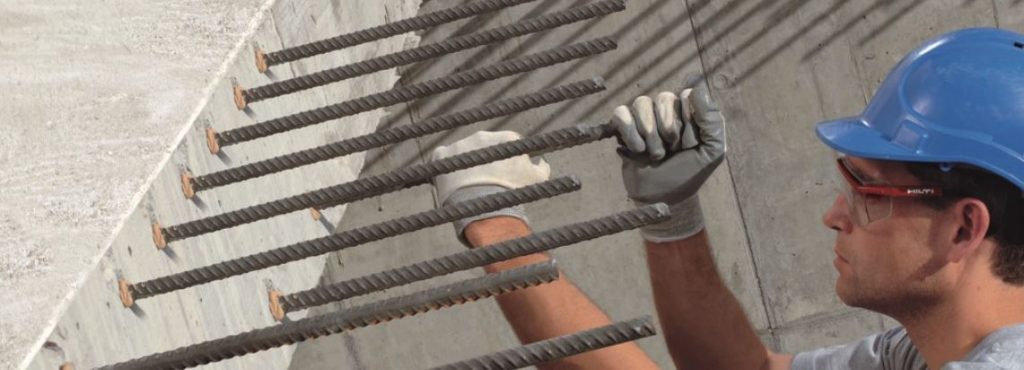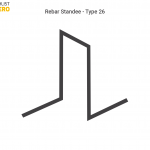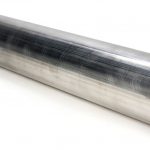Rebar, or reinforcing bar, refers to the steel bars that strengthen concrete that is subject to tensile loads. One of the important parameters of rebar is its weight. In this article, you will review what a rebar weight chart is and provide answers to some commonly asked questions about rebar weight.

Rebar Weight Chart
A rebar weight chart is a quick reference for reviewing the details of standard rebars. Moreover, they are helpful when it comes to choosing the appropriate rebar for a job.
| Imperial Bar Size | Nominal Diameter (in) | Nominal Diameter (mm) | Weight (lb/ft) | Weight (kg/m) |
| #3 | 0.375 | 9.525 | 0.376 | 0.561 |
| #4 | 0.500 | 12.700 | 0.688 | 0.996 |
| #5 | 0.625 | 15.875 | 1.043 | 1.556 |
| #6 | 0.750 | 19.050 | 1.502 | 2.240 |
| #7 | 0.875 | 22.225 | 2.044 | 3.049 |
| #8 | 1.000 | 25.400 | 2.670 | 3.982 |
| #9 | 1.128 | 28.650 | 3.400 | 5.071 |
| #10 | 1.270 | 32.260 | 4.303 | 6.418 |
| #11 | 1.410 | 35.810 | 5.313 | 7.924 |
| #14 | 1.693 | 43.000 | 7.650 | 11.410 |
| #18 | 2.257 | 57.330 | 13.600 | 20.284 |
Generally, a rebar weight is defined in terms of unit weight per length as specified in imperial and SI units in the chart above. Also, the nominal diameter of the ASTM standard bars increases by 1/8 inch for each rebar size.
Rebar Selection from Weight Chart
The selection of any of the standard rebars from the weight chart depends on the application. Some common uses according to the imperial bar size are as follows:
- Imperial Bar Size #3: This is the smallest size, and often serves in basic applications such as swimming pools, patios, and driveways to add strength to concrete.
- Imperial Bar Size #4: Because of it is slightly thicker, it can provide more robust reinforcement for columns, slabs, and highways.
- Imperial Bar Size #5: Ideal for bridges and highways.
- Imperial Bar Size #6: In addition to highways, this rebar size suits foundations and retaining walls.
- Imperial Bar Size #7: Due to its thickness it can provide support for multi-story facilities.
- Imperial Bar Size #8: Provides adequate strengthening in medium to heavy commercial applications.
- Imperial Bar Size #9: Suitable for high-rise construction and sea walls.
- Imperial Bar Size #10: This provides adequate structural support to beams and columns in medium to heavy commercial projects.
- Imperial Bar Sizes #11 to #18: These offer the heaviest rebar weight and is ideal for load-bearing structures and other heavy-duty applications.
Rebar Selection Based on Steel Type
Apart from the size and weight of the rebar, the type of steel is an important consideration when selecting a rebar. Because the yield and tensile strength vary according to the type of steel. In addition, after selecting the type of steel, its strength characteristics also vary with the grade. The following sections review the various types of steel and their suitability for applications.
Carbon Steel
This is the most common rebar material in residential and industrial projects. This is largely due to its durability and cost-effectiveness. But it does not do well in applications with high moisture exposure. There are three grades of carbon steel depending on the carbon content.
- Low carbon: This has a carbon content of less than 0.31% and is the least expensive. Its high ductility makes it ideal for wires as well.
- Medium carbon: The higher carbon content of between 0.31% and 0.60% makes it less ductile. However, this provides a higher strength capacity than low carbon steel.
- High carbon: With carbon content between 0.61% and 2%, this offers the toughest type, ideal for high-strength rebars.
Alloy Steel
Alloy steel constitutes iron alongside other metals, with each type bringing a unique and desirable characteristic to the rebar. For example, aluminum makes the rebar heat—resistant and improves ductility. While molybdenum improves weldability and corrosion resistance so that exposure to moisture is not detrimental to its integrity. Other common alloys include combinations of iron with copper, manganese, silicon, and vanadium.
Stainless Steel
The key attribute of stainless steel is the presence of chromium, generally above 10.5%. In some cases, this value could rise to 30%. As the chromium content gets higher, the material appears glossier. However, the effect of chromium on the steel is not only for aesthetics. It also provides corrosion resistance (CRES)as it has low levels of oxidation. Some types of stainless steel are ferritic, austenitic, martensitic, and duplex.
Tool Steel
These are alloys that undergo a hardening process via heat treatment to increase their strength. Thus, it makes them suitable for high-impact environments. Due to its high strength and low mass, it can contribute significantly to the strength of the concrete with a minimal increase in the rebar weight. This feature is important in commercial applications and multi-story buildings that require high amounts of reinforcement. Grading of tool steel depends on the heating process used in its formation such as water hardening, oil hardening, and hot working.
Commonly Asked Questions
Because of their common use in a variety of applications, several common questions frequently occur. This section aims to answer some of these questions.
How much does a 20 feet piece of rebar weigh?
The weight of a 20 feet piece of rebar depends on its size. For example, using the ASTM rebar weight chart, a 20 feet size #3 rebar will weigh 7.52 lb. For size #18, the weight will be 272 lb.
What number is a 1/2″ rebar?
Again, using the ASTM rebar weight chart, the number of a ½” nominal diameter rebar is #4.
Do all rebars have the same weight?
No, they do not. The weight of rebar depends on its size (nominal diameter). Also, the weight will depend on the type of steel used in making the rebars. Generally, they are standard rebar weight charts that serve as a quick reference for checking weights. But unique situations may require the use of materials whose details are yet to be documented in these standard charts.
Does the weight of a rebar matter in construction?
Rebar weight is an important parameter in construction because it adds to the overall weight of the structure. The larger the size of a rebar, the heavier it is. So, when choosing rebar, it is necessary to optimize between the size of the rebar and the strength it will deliver in supporting the structure.



